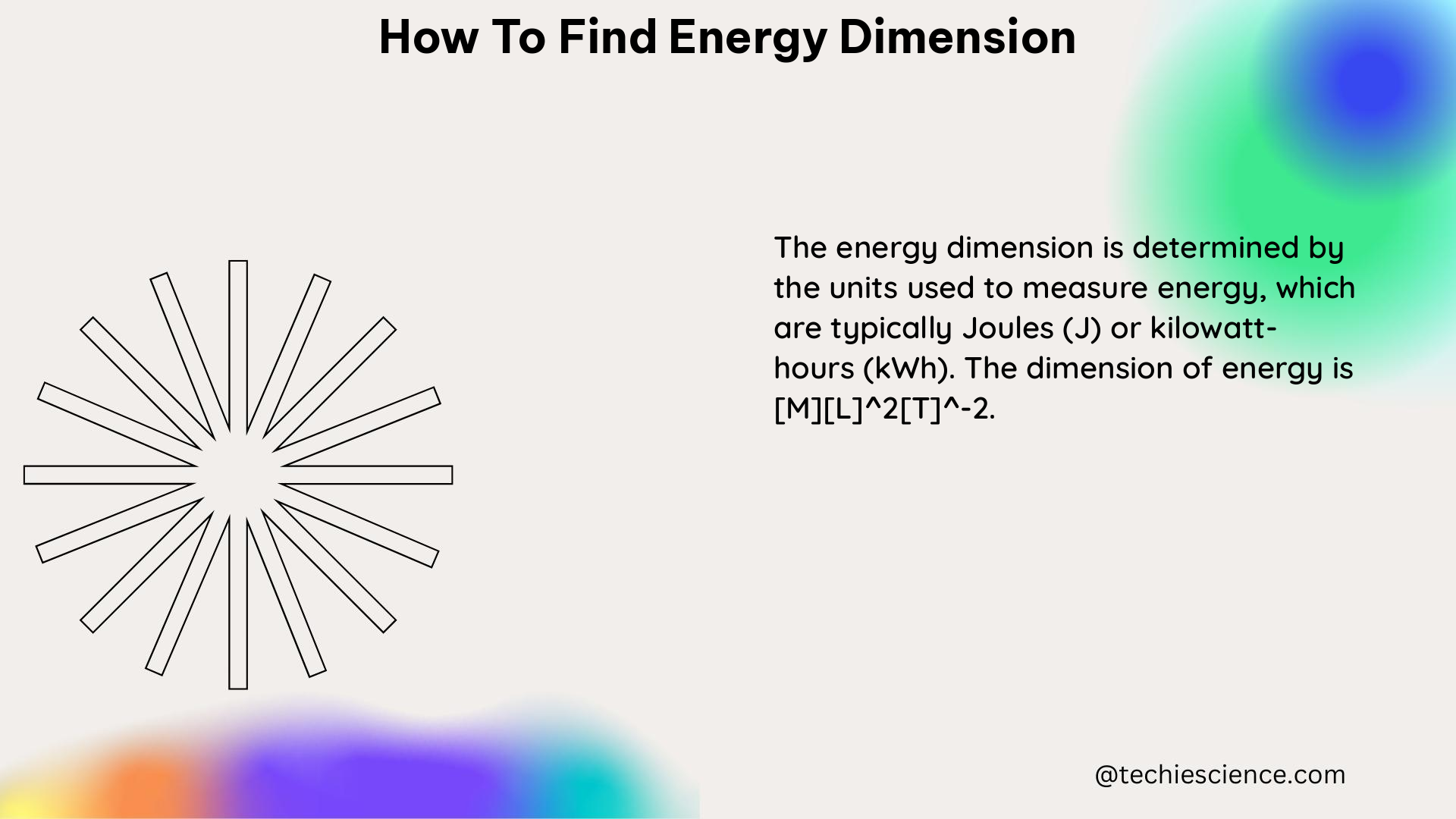Summary
Measuring and quantifying the energy dimension involves understanding various aspects of energy, such as its units, power, and physical activity level. This comprehensive guide delves into the key concepts, formulas, and practical examples to help you accurately determine the energy dimension in different scenarios.
Understanding Energy Units

Energy can be measured using various units, each with its own specific applications and conversion factors. The standard (SI) unit of energy is the Joule (J), which represents the work done when a force of one Newton (N) is applied over a distance of one meter (m). Other common energy units include:
- Kilocalorie (kcal): 1 kcal = 4,184 J
- British Thermal Unit (BTU): 1 BTU = 1,055.06 J
- Kilowatt-hour (kWh): 1 kWh = 3,600,000 J
- Therm (thm): 1 thm = 105,505,600 J
Mastering the conversion between these units is crucial for accurately measuring and comparing energy values.
Calculating Power
Power is the rate at which energy is transferred or converted from one form to another. The standard unit of power is the Watt (W), which is defined as one Joule per second (J/s). To calculate the power of a device or system, you can use the following formula:
Power (W) = Energy (J) / Time (s)
This formula allows you to determine the power output or consumption of various energy-related systems, such as electrical appliances, mechanical devices, or even human physical activity.
Assessing Physical Activity Level (PAL)
The Physical Activity Level (PAL) is a measure of an individual’s daily physical activity, expressed as a multiple of their basal metabolic rate (BMR). The BMR represents the amount of energy expended by an individual at rest, while the PAL takes into account the energy expenditure during physical activity and other physiological processes.
To calculate the PAL, you need to know the individual’s age, weight, height, and a detailed list of the activities performed, their intensity (in METs), and the duration (in minutes) for each activity within the past 24 hours. The MET (Metabolic Equivalent of Task) value is a numerical representation of the intensity of an activity, where one MET equals the resting metabolic rate of 3.5 ml of oxygen per kilogram of body weight per minute (ml/kg/min).
The PAL is calculated using the following formula:
PAL = Total Energy Expenditure (TEE) / Basal Metabolic Rate (BMR)
By determining the PAL, you can gain insights into an individual’s overall physical activity level and its impact on their energy requirements.
Estimating Energy Requirements (EER)
The Estimated Energy Requirement (EER) is a predictive equation that estimates an individual’s daily energy needs based on their age, weight, height, sex, and PAL. The EER formula is as follows:
EER = BMR × PAL × (1.15 + 0.055 × T)
Where:
– BMR is the basal metabolic rate
– PAL is the physical activity level
– T is the number of hours per day the individual is in thermal balance
By using this formula, you can determine the estimated energy requirements for an individual, which is crucial for understanding their overall energy balance and making informed decisions about their dietary and physical activity needs.
Practical Examples and Numerical Problems
Let’s explore some practical examples and numerical problems to illustrate the application of the concepts and formulas discussed:
- Energy Unit Conversion:
- Convert 1,000 kcal to Joules.
- Convert 500 BTU to Joules.
-
Convert 2.5 kWh to Joules.
-
Power Calculation:
- A device consumes 1,200 J of energy in 10 seconds. Calculate the power of the device.
-
A person performs a physical activity that expends 800 J of energy in 2 minutes. Calculate the power output.
-
PAL Determination:
- An individual’s BMR is 1,800 kcal/day, and their TEE is 2,700 kcal/day. Calculate their PAL.
-
A person’s daily activities include 30 minutes of walking (4 METs), 45 minutes of cycling (6 METs), and 60 minutes of light housework (2 METs). Calculate their PAL.
-
EER Calculation:
- A 30-year-old female weighing 60 kg and standing 165 cm tall has a PAL of 1.6 and is in thermal balance for 16 hours per day. Calculate her EER.
- A 45-year-old male weighing 80 kg and standing 175 cm tall has a PAL of 1.8 and is in thermal balance for 18 hours per day. Calculate his EER.
By working through these examples, you can develop a deeper understanding of how to apply the concepts and formulas to find the energy dimension in various real-world scenarios.
Conclusion
Determining the energy dimension involves a comprehensive understanding of energy units, power, physical activity level, and estimated energy requirements. This guide has provided you with the necessary tools and formulas to accurately measure and quantify the energy dimension in different contexts, from personal energy expenditure to the performance of devices and systems.
By mastering these concepts, you can make informed decisions, optimize energy usage, and gain valuable insights into the energy dynamics of your surroundings. Remember to continue practicing and applying these principles to solidify your understanding of the energy dimension.
References:
- Energy Measurement | Units & Conversions – Lesson – Study.com
- An Easy Approach to Calculating Estimated Energy Requirements
- The 6 Data Quality Dimensions with Examples – Collibra
- Measurable Quantity – an overview | ScienceDirect Topics
- Measurement | Learn Green Software

The lambdageeks.com Core SME Team is a group of experienced subject matter experts from diverse scientific and technical fields including Physics, Chemistry, Technology,Electronics & Electrical Engineering, Automotive, Mechanical Engineering. Our team collaborates to create high-quality, well-researched articles on a wide range of science and technology topics for the lambdageeks.com website.
All Our Senior SME are having more than 7 Years of experience in the respective fields . They are either Working Industry Professionals or assocaited With different Universities. Refer Our Authors Page to get to know About our Core SMEs.